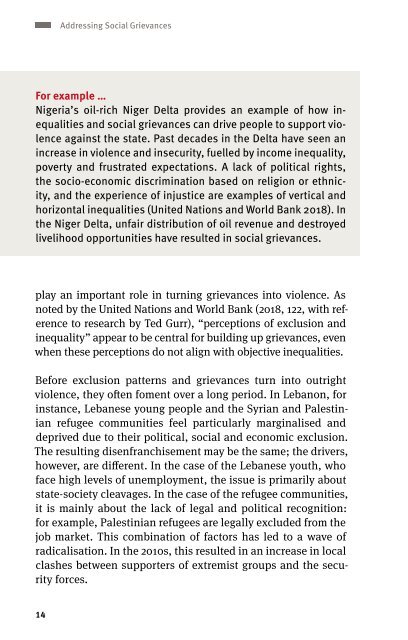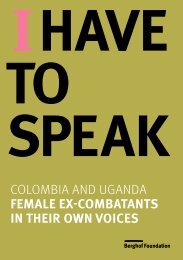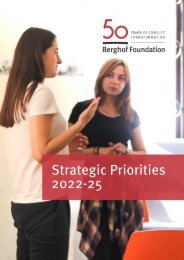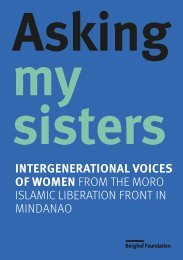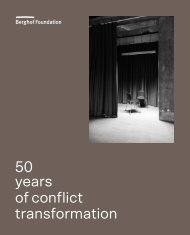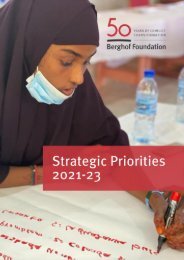Berghof Glossary on Conflict Transformation
The Berghof Glossary on Conflict Transformation presents 20 of the main principles and approaches used by the Berghof Foundation in its work. It is a concise and accessible exploration of what it takes to create “space for conflict transformation”. 2019 edition.
The Berghof Glossary on Conflict Transformation presents 20 of the main principles and approaches used by the Berghof Foundation in its work. It is a concise and accessible exploration of what it takes to create “space for conflict transformation”. 2019 edition.
Create successful ePaper yourself
Turn your PDF publications into a flip-book with our unique Google optimized e-Paper software.
Addressing Social Grievances<br />
For example …<br />
Nigeria’s oil-rich Niger Delta provides an example of how inequalities<br />
and social grievances can drive people to support violence<br />
against the state. Past decades in the Delta have seen an<br />
increase in violence and insecurity, fuelled by income inequality,<br />
poverty and frustrated expectati<strong>on</strong>s. A lack of political rights,<br />
the socio-ec<strong>on</strong>omic discriminati<strong>on</strong> based <strong>on</strong> religi<strong>on</strong> or ethnicity,<br />
and the experience of injustice are examples of vertical and<br />
horiz<strong>on</strong>tal inequalities (United Nati<strong>on</strong>s and World Bank 2018). In<br />
the Niger Delta, unfair distributi<strong>on</strong> of oil revenue and destroyed<br />
livelihood opportunities have resulted in social grievances.<br />
play an important role in turning grievances into violence. As<br />
noted by the United Nati<strong>on</strong>s and World Bank (2018, 122, with reference<br />
to research by Ted Gurr), “percepti<strong>on</strong>s of exclusi<strong>on</strong> and<br />
inequality” appear to be central for building up grievances, even<br />
when these percepti<strong>on</strong>s do not align with objective inequalities.<br />
Before exclusi<strong>on</strong> patterns and grievances turn into outright<br />
violence, they often foment over a l<strong>on</strong>g period. In Leban<strong>on</strong>, for<br />
instance, Lebanese young people and the Syrian and Palestinian<br />
refugee communities feel particularly marginalised and<br />
deprived due to their political, social and ec<strong>on</strong>omic exclusi<strong>on</strong>.<br />
The resulting disenfranchisement may be the same; the drivers,<br />
however, are different. In the case of the Lebanese youth, who<br />
face high levels of unemployment, the issue is primarily about<br />
state-society cleavages. In the case of the refugee communities,<br />
it is mainly about the lack of legal and political recogniti<strong>on</strong>:<br />
for example, Palestinian refugees are legally excluded from the<br />
job market. This combinati<strong>on</strong> of factors has led to a wave of<br />
radicalisati<strong>on</strong>. In the 2010s, this resulted in an increase in local<br />
clashes between supporters of extremist groups and the security<br />
forces.<br />
14


